This post gets updated as new information appears. See update notes at the end for significant changes. In addition to the links at the end, I encourage you to read Michael S. Howard’s article on the development of divination and cartomancy here.
The 15th Century
1414 Barcelona – Joch de nayps moreschs
Two Barcelona inventories have entries for “joch de nayps (or ‘nahyps’) moreschs”. The Instituto Municipal de Historia in Barcelona formerly held several sheets of uncut woodblock cards of the Moorish design from around this period. Their similarity to the late 15th or early 16th century Mamluk playing cards is obvious. What makes this important to our discussion is that the latter cards (see below) have calligraphic texts along the tops of the cards consist of rhyming aphorisms that are clearly predictions of one’s fortune. Here are a few of the translations given on Simon Wintle’s outstanding website The World of Playing Cards. Decide for yourself what you would think if you drew a card with such a saying upon it:
“As for the present that rejoices, thy heart will soon open up“
“With the sword of happiness I shall redeem a beloved who will afterwards take my life“
“O my heart, for thee the good news that rejoices”
“Rejoice in the happiness that returns, as a bird that sings its joy”
“The alif rejoices and fulfils your wishes”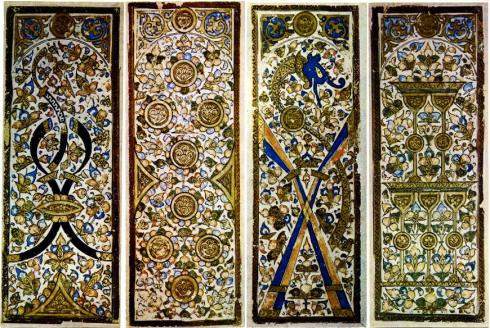
c. 1450 – Juego de Naypes
Ross Caldwell reports here on a Spanish “Juego de Naypes” (Game of Cards) by Fernando de la Torre, dedicated to the Countess of Castañeda, written around 1450. It is played with a 49 card deck, having only two court cards per suit plus an additional Emperador card “which wins over all the other cards” (que gane a todas las otras cartas). In this game “one can cast lots [tell fortunes] with them to know who each one loves most and who is most desired and by many other and diverse ways” (puédense echar suertes en ellos á quién más ama cada uno, e á quién quiere más et por otras muchas et diversas maneras). On each card is to be written a verse having the same number of lines as the number of the card, with each suit describing love according to different categories of women: Oros are Maidens, Copas are Wives, Bastones are Widows and Espadas are Nuns. Early Spanish/Morisca cards can be seen here.
This seems an unambiguous description of divination with playing cards that also includes a single additional “trump” card.
The 16th Century
1505 – “Lot” Books
Playing cards were used for fortune telling in conjunction with the 1505 German Mainz Kartenlosbuch (literally, card-lot/fortune book). Fortunes in this work include such things as:
- You’re criticized because of too much avarice. You’ll lose a tooth and a thief will spend your money.
- You’ll have good luck, winning honors and riches.
- Secret sorrows, possibly connected to an old love.
Thanks to Huck Meyer at tarotforum for reminding me of this. See page from the text and more card meanings at Trionfi.com, which is, furthermore, one of the best sites on the history of tarot.
Lotbooks or (Losbücher) were described by Dr. Johann Hartlieb in 1456:
“One throws dice [or draws cards, mkg], until one reaches a number; in accordance with that number, one looks for the question [listed in the book], which the person has asked . . . there is nothing one will not find in these questions. Afterward one gets to an old man [often a king, god or hero] who points the way to a judge, who will explain the self-same questions [see illustration above]. This is all a singular disbelief and it stands in sharp opposition to God, for it has neither a spiritual or natural basis and is thus prohibited by the Holy Church in its decrees.”
Hartlieb is not entirely correct in that St. Augustine among other church officials spoke of the proper use of sortes (Latin for “lots”) to obtain answers. With the medieval sortes apostolorum or sortes des saints (composed specifically for divination rather than sortes sanctorum that is directly from scripture) one would consult them only after fasting on bread and water for three days and then a vigil with candles and the chanting of prayers (and sometimes a Mass) and the aspersion of holy water, upon which the sortes were deemed to be an “infallibly and entirely Christian oracle.” Of course, limiting the sources to apostles, saints, or scripture and the querents to those who could read Latin was an obvious attempt to limit divination to the educated few and forbid it to the multitudes.
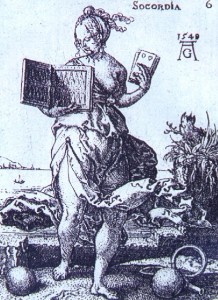 Socordia is Latin for laziness and idleness and so is shown with various games.
Socordia is Latin for laziness and idleness and so is shown with various games.
1507 – On the Foreknowledge of Things
In 1507 Francesco Pico della Mirandola (nephew of the better known Giovanni) wrote De rerum praenotione (“On the Foreknowledge of Things”) in which he supports the ability of divinely appointed prophets to know the future, while attacking all other forms of divination, including astrology, geomancy, palmistry and all kinds of sortilege/lots:
There are many kinds of lots [sortium], as in casting bones, in throwing dice, in the figures depicted in a pack of cards [in figuris chartaceo ludo pictis]; and in the expectation of whatever first should arrive, in picking the longer husk, or in casting the eyes on a page. [Thanks to Ross Caldwell–see link to his paper describing this at the end of this post.]
Being a work from Italy that specifically mentions the figures pictured on cards suggests that Pico may well have been referring to the tarot.
c. 1508 – “The Fortune-Teller” by Lucas van Leyden
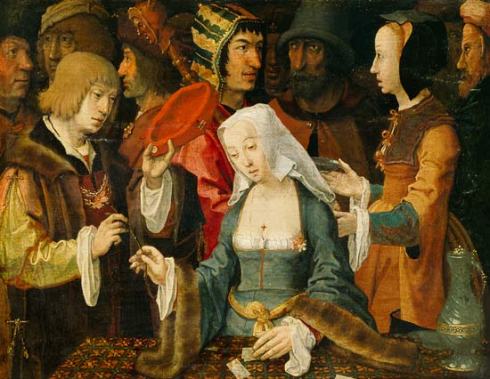
While this painting by Lucas van Leyden (1494-1533) has been called, in modern times, “The Fortune Teller” (c. 1508), it more likely commemorates Margarethe (Margaret) of Austria’s ascendancy to the governorship of the Netherlands in 1507 following the death of her brother, Philip the Handsome. Alternately, this painting may be commemorating Margarethe’s tragic three year marriage to Philibert (Phillip) of Savoy. By the age of 24 Margarethe had already lost a fiance and two husbands. She decided never to remarry and took the motto: FORTUNE . INFORTUNE . FORT.UNE (“Fortune, Unfortunate, Strength [in/of] One”}, which could be what is being symbolically portrayed. Both this painting and a 19th c. etching based on it has been cited as proof of early playing card divination (see “Chambers” below). Whatever is going on, it seems clear that the fall of the cards is an indicator of a fateful turn-of-fortune. Read my post here for more details. [Special thanks to Huck, Rosanne, and Alexandra—all who had pieces of the puzzle.]
1527 – Merlini’s Caos del Triperiuno
Teofilio Folengo’s 1527 work Caos del Triperiuno (written under the pseudonym Merlini Cocai) includes a series of poems representing the fortunes of people revealed by the cards dealt them. In this sonnet we find the twenty-two Triumph cards. Note that Death in Italian is the feminine la morte, and Love (Eros) is male. Love claims that although Death rules the physical body, Love never dies and therefore death is but a sham.
Love, under whose Empire many deeds (6, 4)
go without Time and without Fortune, (9, 10)
saw Death, ugly and dark, on a Chariot, (13, 7)
going among the people it took away from the World. (21)
She asked: “No Pope nor Papesse was ever won (5, 2)
by you. Do you call this Justice?” (8 )
He answered: “He who made the Sun and the Moon (19, 18 )
defended them from my Strength. (11)
“What a Fool I am,” said Love, “my Fire, (0, 16)
that can appear as an Angel or as a Devil (20, 15)
can be Tempered by some others who live under my Star. (14, 17)
You are the Empress[Ruler] of bodies. But you cannot kill hearts, (3)
you only Suspend them. You have a name of high Fame, (12)
but you are nothing but a Trickster.” (1)
Translated by Marco Ponzi (Dr. Arcanus) with help from Ross Caldwell and members of Aeclectic Tarot’s TarotForum.
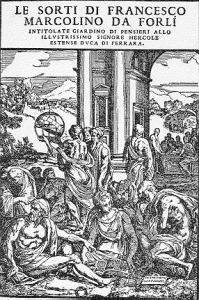 1540 – Marcolini’s Garden of Thoughts
1540 – Marcolini’s Garden of Thoughts
Another early use of playing cards as oracle comes from Le sorti intitolate giardino d’i pensieri (“The oracle called garden of thoughts) from 1540 Venice, published by typographer Francesco Marcolini with text by the Venetian poet Lodovico Dolce. Read all about it through the title’s link. The method of getting the oracle takes one through a convoluted series of steps to end up at a simple tercet of a type as follows:
Do not take an ugly and angry wife,
But even if you take one pleasant and nice,
I am afraid something strange will happen.
1556 – The Sin of Divining with Cards
In 1556, Martin de Azpilcueta (d. 1586) wrote in his Compendio del Manual de Confessores (an instruction book for confessors):
Lo quinto, pecca el que pregunta, o quiere preguntar al adeuino de algun hurto, o otra cosa secreta, o procura de la saber por suertes de dados, cartas, libros, harnero, o astrolabio, y el que encanto bruto animals, con palabras profanas, o sagradas, con obseruancia de alguna vanidad.
Fifth, he sins who asks, or wants to ask the diviner of some theft or other secret thing, or gain knowledge through the luck of dice, playing cards, books, sieve, or astrolabe, and he who enchants brute beasts, with words profane or sacred, with the observance of any vanity.
This book was later translated into Latin and published in France as: Martin de Azpilcueta, “Enchiridion sive Manuale Confessariorum et Poenitentium” (Paris, François Huby, 1620): c. XI, note 30 (p. 191). Thanks to Ross Caldwell for first finding this and to “Doctor Arcanus” for the Spanish original.
It should be noted that condemnation by the Church usually indicates that such deeds are rampant in the culture.
The 17th Century
1620 – Henry Cuffe and the Three Knaves
In 1620 John Melton recorded the following story in Astrologaster, or, The Figure Caster. It was repeated by William Rowland, in Judiciall astrologie, judicially condemned (London, 1652) and tells of Henry Cuffe, (1563-1601), secretary to the Earl of Essex, whose death was foretold by cards twenty years before it happened. Cuffe was executed in 1601, so the incident allegedly dates from 1581 when he would have been 18 years old:
“There was another Wizard (as it was reported to me by a learned and rare Scholler, as we were discoursing about Astrologie) that some twentie yeeres before his death told Cuffe our Countreyman, and a most excellent Graecian, that hee should come to an untimely end: at which, Cuffe laughed, and in a scoffing manner entreated the Astrologer to shew him in what manner he should come to his end: who condiscended to him, and calling for Cards, entreated Cuffe to draw out of the Packe three, which pleased him; who did so, and drew three Knaves: who (by the Wizards direction) layd them on the Table againe with their faces downewards, and then told him, if hee desired to see the summe of his bad fortunes reckoned up, to take up those Cards one after another, and looke on the inside of them, and he shluld be trouly resolved of his future fortunes. Cuffe did as he was prescribed, and first took up the first Card, and looking on it, he saw the true portraiture of himselfe Cape a Pe [head to foot], having men compassing him about with Bills and Halberds: then he tooke up the second Card, and there saw the Judge that sat upon him: at last, he tooke up the last Card, & saw Tyborne, the place of his Execution, & the Hangman, at which he then laughed heartily; but many yeres after, being condemned for Treason, he remembred the fatall Prediction of the Wizard, & before his death revealed it to some of his friends. If this be true, it was more then Astrology, and no better then flat Sorcery or Conjuring, which is divellish.” [John Melton, Astrologaster, or, The Figure Caster, p.42. Thanks to Michael J. Hurst.]
Edwin S. Taylor in The History of Playing Cards (1865), claimed the cards were the Devil, Justice and Hanged Man, but there is no justification for this in the original text, which refers to three Knaves (probably Jacks/Valets). Whether the incident actually occurred or not, the account shows that fortune-telling by cards was known in England by this time.
“The Allegory of Fortune” (mid-17th century)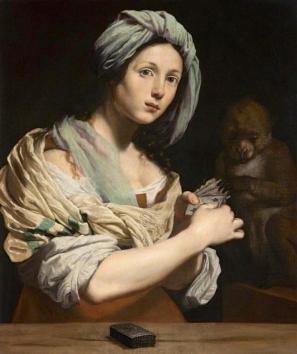
“The Allegory of Fortune” by Lorenzo Lippi (1606-1665), from Florence Italy, now in the National Museum of Northern Ireland, Ulster, depicts Fortune as being dependent upon the vagaries of chance similar to that of a monkey (seen on the right) selecting playing cards. Fortune herself, dressed as a gypsy, gazes out at the viewer as if to say, “Do you dare take whatever my companion chooses to give you?” What seems almost certain is that the gypsy woman is an allusion to fortune-telling. Furthermore, fortune-tellers in Europe, Africa and Asia, even today, use trained animals, usually birds, to select cards that reveal a querent’s future.
1665 – The Lenthall Fortune-Telling Deck
A deck of 52 fortune-telling cards was originally designed by Dormann Newman and published by John Lenthall of The Talbot, Fleet Street, London, in 1665. (The cards below are from the 3rd edition of 1714, published in facsimile by Harry Margary, Lympne Castle, Kent in 1972.) Update: These appear to have also been published by James Moxon (either father or son), who were British engravers and map-makers as well as producing a whole variety of geographic and educational cards. These card appear identical with a deck they published as “Astrology Cards” in 1676 [trionfi.com].
Each suit was numbered I to XIII. Odd numbered cards had a sign of the zodiac on them; even numbered cards contained a list of thirteen numbered statements. The Kings had a series of questions one could ask. The court cards were given the names of famous people from myth and legend. According to the directions, “When any person is desirous to try their fortune, let them go to one of the four kings and choose what question they please.” This is followed by an elaborate procedure for determining the answer. The explanation ends, “The stars foretell, they love you well.”
Lenthall later published a set of Proverb cards.
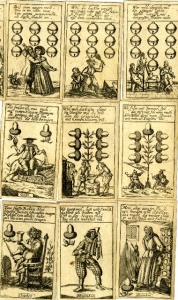 17th century – German Proverb decks
17th century – German Proverb decks
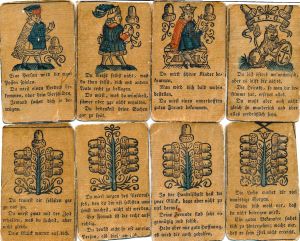 Quite a few old German decks featuring proverbs and sayings that must have been used for obtaining advice and prognostication of how a situation would progress. The suits consist of Green Leaves (Spades), Red Hearts (Hearts), Yellow Bells (Diamonds) and Black Acorns (Clubs). Acorns (Clubs) are generally the worst suit, while the Green Leaves (Spades) are the best suit.
Quite a few old German decks featuring proverbs and sayings that must have been used for obtaining advice and prognostication of how a situation would progress. The suits consist of Green Leaves (Spades), Red Hearts (Hearts), Yellow Bells (Diamonds) and Black Acorns (Clubs). Acorns (Clubs) are generally the worst suit, while the Green Leaves (Spades) are the best suit.
16th & 17th century – Witchcraft and Cards
Focusing on the 16-17th centuries are reports in Italy, Spain and Belgium of witchcraft using playing cards. Whether this included fortune-telling as we know it is unclear. See my post on this subject HERE. In addition to transcripts of court trials, one of the most conclusive pieces of evidence for the use of cards in ritual is from a painting by David Teniers the Younger (1610-1690), now lost but reproduced as an engraving in the 18th century. Here is a photograph from my visit to an exhibit on witchcraft engravings at the British Museum.
The 18th Century
1702 – Fortune Telling Cards for sale
Advertisement for a deck of “Fortune Telling Cards” in The Post Man and The Historical Account, London, Dec. 22, 1702:
1727 – Destiny in a Game of Picquet
A book called Whartoniana; or, Miscellanies, in verse and prose by members of the Wharton family (and several other persons of distinction) was translated from the French and published in 1727. (Edited by Edmund Curll and translated by Joseph Morgan). It contained a detailed account of a card game that resulted in a divination. In the Table of Contents the piece is titled “To the lovely PALLAS, Or the Game at Picquet.” [Thanks to Stephen J. Mangan, (aka Kwaw) at Aeclectic’s tarotforum for finding this.]
A few Days ago, I took it into my Head to make a Visit to the celebrated Theresius, in order to be informed of my Destiny. —Help thyself to a Seat, said he, my Friend, sit down, and give me thy Hand. He pored on it for a considerable while, cast a Figure, said not one Word, but ordered me to return the next Day. His Silence seemed to me very ominous, and to portend me no Good; yet I much rather chose to be at once acquainted with my ill Fortune, than to continue longer in a suspenceful Uncertainty. I therefore very importunately pressed him to let me know his Reason for giving me no Answer to my Quere. Still the old Cuff was mute, making no manner of Reply, but reaching a Pack of Cards, sat down by me, and challenged me to play a Game with him at Piquet; the which, heavy-hearted and out of Humour as I was, I could not, nay durst not well refuse.
Well.— We cut; he has the Hand; I deal; he takes five, and leaves me three.— I find in my Hand a Quint in Hearts, three Kings, three Knaves, the Queen of Diamonds, and three Spades which I discarded. A promising Game! Great Hopes! But, Morbleu! Not one Ace in the three Cards I took in!— Faith, Madam ; I beg your Pardon for swearing; but it was so cursedly provoking, that I cannot keep my Temper when ever I think of it.
Sixty five? says he.— Good.— A Quint to a Knave?— Equal.— He then spreads out upon the Table seven Diamonds. Sixty five are seven, says my Antagonist, very gravely; a Quatorze of Aces, fourteen more.— All good, cries I, with a deep Sigh.— Diamonds, says he, playing his Ace, twenty-two, and plays out all his Diamondsrunning.— Down went my Queen, accompanied with two Clubs and four Hearts.— He next plays his Ace of Clubs, and that quite confounds me; for, the most unluckily in the World, I had left my King unguarded. He redoubles upon me with the Ten of Clubs; I fling him a Spade. Next, upon his Ace of Hearts, I give my Knave, still depending upon saving the Lurch, scarce doubting of his having the Queen.— My King of Spades next falls a Victim to his Ace.— But, how was I Thunder-struck! How were all my Hopes blasted! The Devil a Bit of the Queen of Hearts had he, and poor Charles found himself Capoted.
I have won the Game, said he.— From hence learn thy Destiny. If you must love, pitch upon some Object that is more your Match: For if ever you attack the divine Pallas, you will infallibly be Lurched.— Adieu. Heaven take thee into it’s Protection: Thus we parted.
- Lurch – a decisive defeat in a game (especially in cribbage).
- Capote – to win all the tricks from an opponent in a game of piquet.
 1729-50 – Dr. Flamstead’s and Mr. Patridge’s New Fortune-Book containing . . . Their new-invented method of knowing one’s fortune by a pack of cards (in various editions).
1729-50 – Dr. Flamstead’s and Mr. Patridge’s New Fortune-Book containing . . . Their new-invented method of knowing one’s fortune by a pack of cards (in various editions).
I found the source of the card fortune-telling verses quoted below in John Brand’s Observations on the popular antiquities of Great Britain (1777). They are from Dr. Flamstead’s and Mr. Patridge’s New Fortune-Book containing . . . Their new-invented method of knowing one’s fortune by a pack of cards. Read about it here.
1730 – Playing Card Divination in the early 18th century London Theatre
Read the earliest example of an actual card reading from a 1730 London play, Jack the Gyant-Killer – HERE, in which it is said that divination with cards is a newly-invented art. And what does this all have to do with a young Ben Franklin and Henry Fielding (author of the classic, Tom Jones, and founder of the first municipal police force, the Bow Street Runners) being led astray by one, A. Primcock? Note that despite the simplicity of the card reading method in the Flamstead and Patridge book, the play describes a technique that became the standard, still used today. The cards are spread in rows—probably 6 rows of 9 cards, except only 7 in the bottom row, as described in the 1791/3 book mentioned below.
1734 – On a Young Lady’s telling a Gentleman his FORTUNE on a Pack of CARDS
from The Gentleman’s Magazine, or The Monthly Intelligencer, October, 1734 we find this delightful little poem that seems to be addressed to one Mrs. Anna M**** of Doncaster. While it may simply be a poem, by addressing a specific woman, it seems more as if he wants to remind her of a fond tryst. It goes:
In mystick leaves, while Anna* deals my fate,
And gives me joys of wedlock, wealth, and
Her wit and beauty, innocence and art, [state:
Ravish my soul, and rob me of my heart:
My hopes and bliss in her alone remain,
I scorn the world my Sybil to obtain.
Cassandra thus the fate of Troy fore-shew’d.
And raging flames her flying words pursu’d.
*Mrs Anna M**** Doncaster.
1735 – Gypsy Cartomancy – a Hoax!
The Square of Sevens, and the Parallelogram: An Authoritative Method of Cartomancy with a Prefatory Note is a literary hoax. Said to be originally written by one Robert Antrobus and published in 1735, it was then edited by E. Irenaeus Stevenson and republished by Harper & Brothers, NY, in 1896. Read all about Ross Caldwell’s literary detective work showing that this book is a 19th century hoax – here.
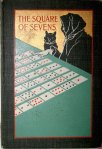
1738 – Divination in Holland
In 1738, Antoine de La Barre de Beaumarchais writes about divination in Holland:
“That kind of divination is not the only one that still persists in Holland, despite its inhabitants common sense. Pyromancie and Ooscopy, or to speak in a more casual way, the art of guessing by watching a flame, burning coal, sparkles, eggs in a glass, are still commonly used in some part of Holland. The fortuitous disposition of a playing card deck, open and arranged in four or five lines, is another way to tell the future, not despised by certain ladies from this country. It is true that some of them pretend consulting the so-called witches for the sake of distraction. But one would think the exact opposite, seeing how they await with an attentive and worried attitude these women answers, and how they manifest their joy by the sudden serenity on their faces, when those Oracles are favorable.”
(Contributed by Bertrand—see comments.)
17??-1750 – Pratesi’s Bolognese Tarocchi
A manuscript written prior to 1750 was discovered by Italian playing card scholar, Franco Pratesi in the late 1980s. It lists cartomantic interpretations for 35 Bolognese tarocchi cards along with a rudimentary method of laying them out. A sheet of 35 Bolognese cards (trumps and number cards) are labeled with simple divinatory meanings such as “journey,” “betrayal,” “married man,” “love.” A later deck of double-headed Bolognese cards from the 1820’s are labeled both top and bottom with similar divinatory meanings, showing a continuity of use. A comparison of four variations on Bolognese divinatory meanings can be found here.
1750 Sketchley’s Conversation Cards and “The Complete Fortune Teller,” along with an advertisement for these cards from The Virginia Gazette of 1775.
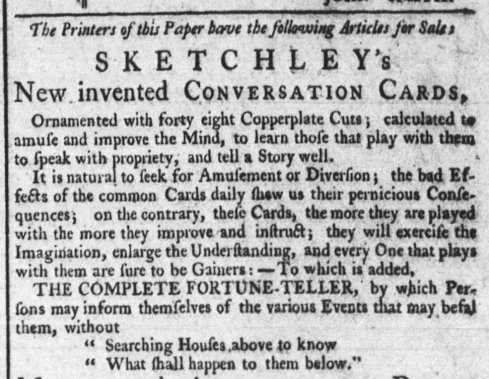
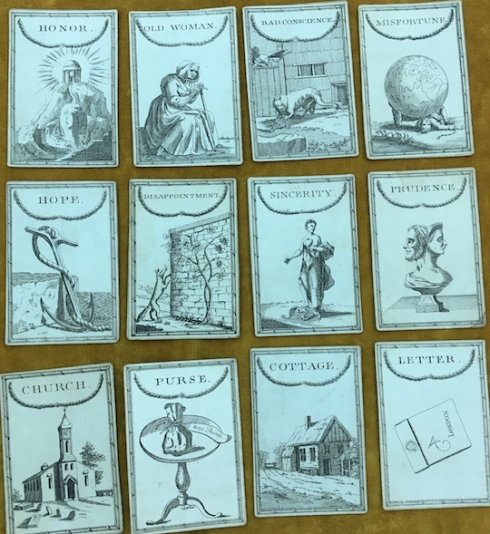
So, to this set of cards was added “The Complete Fortune Teller” – a standard book of the time. As it turns out, James Sketchley was a British publisher who produced, from at least 1750 in England, the “Conversation Cards” as an educational game for children. In addition, he was an ardent Freemason of whom it was said:
“A man, who, if Masonry e’er was the theme
His bosom with Rapture would glow and expand.”
Thanks to Andrew McGregor who obtained a photo of these cards for me from the Toronto Public Library Osborne Collection.
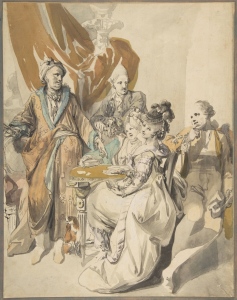 mid-18th century – Cagliostro Reads the Cards
mid-18th century – Cagliostro Reads the Cards
A watercolor by Johann Eleazar Zeissig (called Schenau), mislabeled at the Metropolitan Museum of Art as “Two Women and Three Men Playing Cards.” Cagliostro is identified, in French, on the reverse of the picture, but not acknowledged in the description of the work. He appears to be doing a card reading for a group of nobles. Cagliostro points to the Ace of Hearts or Diamonds (probably Hearts!) that the woman in the foreground is showing to him. Note how his “oriental” robe contrasts with their clothes and his cap is a type worn by those in the “arts.” A later print in a book by Julia Orsini repeats the claim that Cagliostro read cards (see below).
1755 – The Card
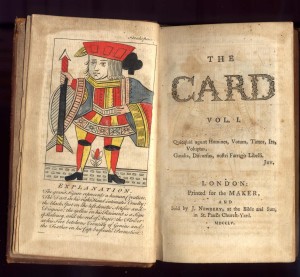 In 1755 we find a rambling novel in two volumes, The Card by John Kidgell (London: Printed for the Maker and sold by J. Newberry, 1755), that is famous as the first reference to a game of “baseball.” It is notable to us because of the frontispiece that features a large engraving of the Jack (or Knave) of Clubs, accompanied by a detailed commentary on its symbolism. I haven’t been able to find an online copy of the book to discover the role this figure plays in the text, but I would imagine it serves as Significator of the main character of the novel. It shows the kind of symbolism we tend to look for in cards when ‘reading’ them. Usually associated with Lancelot, this Jack also has a reputation as the scoundrel of the pack. The text explains:
In 1755 we find a rambling novel in two volumes, The Card by John Kidgell (London: Printed for the Maker and sold by J. Newberry, 1755), that is famous as the first reference to a game of “baseball.” It is notable to us because of the frontispiece that features a large engraving of the Jack (or Knave) of Clubs, accompanied by a detailed commentary on its symbolism. I haven’t been able to find an online copy of the book to discover the role this figure plays in the text, but I would imagine it serves as Significator of the main character of the novel. It shows the kind of symbolism we tend to look for in cards when ‘reading’ them. Usually associated with Lancelot, this Jack also has a reputation as the scoundrel of the pack. The text explains:
“The grand figure represents a human Creature. The Dart in his right Hand intimates Cruelty; the black Spot on the left denotes Artifice and Disguise; the yellow in his Raiment is a Sign of Jealousy, and the red of Anger; the Flower at his feet betokens Vivacity of Genius and the Feature in his Cap bespeaks Promotion.”
1762/3 – The Vicar of Wakefield – “A very pretty manner of telling fortunes”
In 1762-3 Oliver Goldsmith writes his novel The Vicar of Wakefield in which we find that reading cards can be an admirable accomplishment in a young woman:
And I will be bold to say my two girls have had a pretty good education, and capacity, at least the country can’t shew better. They can read, write, and cast accompts; they understand their needle, breadstitch, cross and change, and all manner of plain-work; they can pink, point, and frill; and know something of music; they can do up small cloaths, work upon catgut; my eldest can cut paper, and my youngest has a very pretty manner of telling fortunes upon the cards.’ [in Chapter 11]
1765 – The Oracle, a pack of cards
An advertisement for an “The Oracle, a pack of Cards” from The Public Advertiser, London, May 17, 1765:
This may be the deck that is pictured here on Simon Wintle’s excellent website.
1765 – Zaïre, Casanova’s Russian mistress
The famous lover, Jacques Casanova, recounts in his memoires that in 1765 his then 13-year-old Russian peasant mistress would read the cards every day—laying them out in a square of twenty-five cards. As he describes it: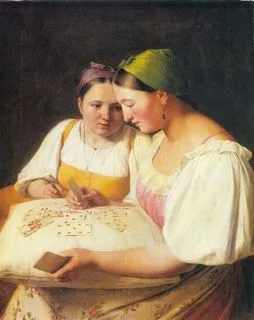
Without her desperate jealousy, without her blind trust in the infallibility of the cards, which she consulted ten times a day, this Zaïre would have been a marvellous woman and I would never have left her.
To convince me of my crime, she shows me a square of twenty-five cards wherein she makes me read all the debaucheries that had kept me out all night long. She shows me the tart, the bed, the love-play and even my unnatural acts. I didn’t see anything at all, but she imagined that she saw everything. After letting her say, without interruption, everything that might serve to assuage her jealousy and rage, I took her grimoire [the deck of cards] and threw it into the fire.
(From The Complete Memoires of Casanova by Jacques Casanova, Chapter CXVII. This translation by Ross Caldwell.) The painting entitled Fortunetelling (1842) is by Alexey Gavrilovich Venetsianov (1780-1847) and is in The Russian Museum, St. Petersburg.
Patience/Solitaire/Kabale
Casanova was one of the first to mention the card game solitaire or patience. Other names for these games suggest an origin in fortune-telling. In France, it was known as réussite (“success”), explained in Littré as “a combination of cards [by] which superstitious persons try . . . to divine the success of an undertaking, a vow, etc.” From at least 1783, Danish, Norwegian, and Icelandic solitaire was called kabal(e), or “secret knowledge,” a term reserved in Polish specifically for fortune-telling with cards. For more, visit David Parlett’s “History of Patience/Solitaire”.
1770 – Goethe has his cards read
In Johann Wolfgang von Goethe’s autobiography Dichtung und Wahrheit (“Poetry and Truth”), he recounts that in 1770, when he was 20 years old, he took dancing classes in Strassburg from a Frenchman with two daughters who had both become enamored of him. He cared only for the younger. The girls brought an elderly fortune-teller to the house who agree to read the cards for all three. She began with the older girl:
“She carefully observed the positions of the cards, but then seemed to falter and be reluctant to speak — “I understand,” said the younger girl, who had already become better acquainted with interpreting this magical board. ‘You are hesitating because you do not want to reveal anything unpleasant to my sister, but that card is cursed!’” (The cards revealed that the older girl loved and was not loved in turn.)
“‘Let us see if it will get better,’ replied the old woman, shuffling the cards and laying them out a second time; but it had only grown worse, as we could all plainly see. The fair one’s card was not only more isolated, but was surrounded with many troubles; her friend had moved somewhat farther away and the intermediate figures had come closer.”
With uncontrolled weeping the older girl fled the room. Goethe couldn’t stand to be present while his cards were read, so he went home. When he returned the next day, the younger sister told him,
“I had the cards laid out for you, and the same verdict was repeated three times, always more emphatically. Your card was surrounded by all sorts of good and pleasant things, by friends and men of importance, and money was not lacking. The women kept themselves at some distance. My poor sister, especially, was always the one farthest away; another girl kept moving closer to you but never came to your side, for a third person, a man, placed himself in the way. I shall have to admit to you that I imagined myself to be the second lady, and after this confession you will best be able to understand my well meant advice. I have pledged my heart and hand to an absent friend, and up to now I have loved him better than anyone else. But possibly your presence would grow to mean more to me than before, and just imagine the difficult position in which you would be between two sisters, one of whom you had made unhappy with your affection, and the other with your coldness, and all this misery would be for nothing and for the sake of a short time. For if we had not already known who you are and what your prospects are, the cards would have set it before my eyes very plainly.”
There ensued a jealous scene with the older sister, and Goethe left, to never see them again. (Thanks to Christian Joachim Hartmann for finding this.)
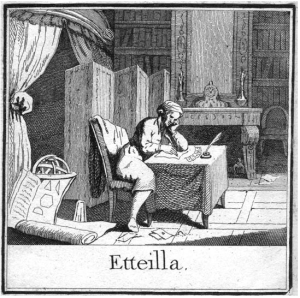 1770 – Paris: Etteilla, and “Illusive Enjoyments of the Mind”
1770 – Paris: Etteilla, and “Illusive Enjoyments of the Mind”
It was around 1750 that the print-seller and teacher of algebra (i.e., numerology), Etteilla (Jean-Baptiste Alliette 1738 – 1791), said he learned the art of telling fortunes with playing cards from three cartomancers, one of whom came from Piedmont in northern Italy. In 1770 he published his own book on fortune-telling with cards, Etteilla, ou manière de se récréer avec un jeu de cartes, for which he coined the term cartonomancie (which became cartomancy). Learn more about Etteilla’s tarot here.
Soon after Etteilla published his book on fortune-telling with playing cards, numerous decks appeared utilizing his system. He followed up with a several books on the Tarot and a Tarot deck. Here is an early miniature “Petit Etteilla” deck from my own collection:
But, as we’ve seen, Etteilla was not really the first to write on the subject. In Germany we find a general Cartomancy text in German (1769): Abhandlung der Physiognomie, Metoposcopie und Chiromantie by Christian A. Peuschel (thanks to Huck).
1777 – From an old English chapbook
John Brand in his 1777 book, Observations on the popular antiquities of Great Britain, quoted from “an old chap book” what he called “curious lines on divination by drawing cards,” the source of which I’ve now found here. Example:
This noble king of diamonds shews
Thou long shalt live where pleasure flows;
But when a woman draws the king,
Great melancholy songs she’ll sing.
1781/89 – Antoine Court, Le Comte de Mellet and Etteilla
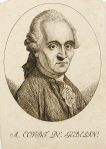 The 8th volume of the encyclopedia Le Monde primitif (“The Ancient World”) by Antoine Court de Gébelin (1725-1784) appears in 1781, claiming an Egyptian origin for Tarot as a book of wisdom. Antoine Court was a friend of Ben Franklin and James Madison who, along with the French King, subscribed to this encyclopedia; Court would die during a medical treatment with Antoine Mesmer (father of hypnotism). The volume includes an essay by le Comte de M*** [Mellet] that explains how to use the cards for divination. De Gébelin says there are 22 Trumps just as there are 22 Hebrew letters; Le Comte de Mellet tells us they correspond to The World as aleph, continuing in reverse order through the cards. It is Le Comte de Mellet also who first calls the suit of coins “talismans” (pantacles), which is later developed by Éliphas Lévi (circa 1865) and used by the Hermetic Order of the Golden Dawn as the suit of Pentacles. The following year Etteilla applies to the censors to publish his own book on the Tarot but is refused until 1783 when he publishes his Manière de se ré créer avec le Jeu de Cartes nommées Tarots (“A way to entertain oneself with the pack of cards called Tarots”), which he follows up with three more volumes and a deck (1789). These works forge the route for Tarot to officially enter the world of occult mysteries and divination. Read some interesting speculations regarding early occult and philosophical uses of the cards HERE.
The 8th volume of the encyclopedia Le Monde primitif (“The Ancient World”) by Antoine Court de Gébelin (1725-1784) appears in 1781, claiming an Egyptian origin for Tarot as a book of wisdom. Antoine Court was a friend of Ben Franklin and James Madison who, along with the French King, subscribed to this encyclopedia; Court would die during a medical treatment with Antoine Mesmer (father of hypnotism). The volume includes an essay by le Comte de M*** [Mellet] that explains how to use the cards for divination. De Gébelin says there are 22 Trumps just as there are 22 Hebrew letters; Le Comte de Mellet tells us they correspond to The World as aleph, continuing in reverse order through the cards. It is Le Comte de Mellet also who first calls the suit of coins “talismans” (pantacles), which is later developed by Éliphas Lévi (circa 1865) and used by the Hermetic Order of the Golden Dawn as the suit of Pentacles. The following year Etteilla applies to the censors to publish his own book on the Tarot but is refused until 1783 when he publishes his Manière de se ré créer avec le Jeu de Cartes nommées Tarots (“A way to entertain oneself with the pack of cards called Tarots”), which he follows up with three more volumes and a deck (1789). These works forge the route for Tarot to officially enter the world of occult mysteries and divination. Read some interesting speculations regarding early occult and philosophical uses of the cards HERE.
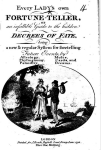 1791 – Every Lady’s Own Fortune Teller
1791 – Every Lady’s Own Fortune Teller
By 1791 we find that the standard fortune telling chapbook has been expanded by a chapter called “Of Card Tossing.” Here are found explicit instructions for reading playing cards, along with a detailed sample reading laid out in 6 rows of 9 cards, with 7 cards in the final row (this edition from 1793, and later editions published with different titles). This is, perhaps, the earliest example in English of instructions that are still roughly current today. There’s also a brief description of coffee-ground reading.
c. 1790s – “The Fortune-Teller” (n.d.) by French artist Martin Drolling (1752-1817)
Napoleon’s soldiers and their families seek reassurances about what is coming next in their lives.
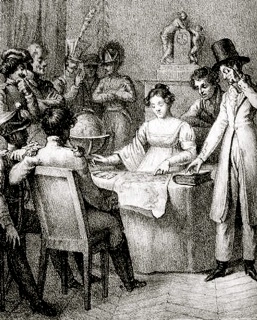 1790 to mid 19th century – The Career of Mlle. Lenormand
1790 to mid 19th century – The Career of Mlle. Lenormand
Around 1790 Marie-Ann-Adélaïde Lenormand (1772-1843) arrived in Paris saying she had learned to read the cards from gypsies (read about her here). With Etteilla’s several books on the subject and the dozen or so self-promoting works by Lenormand and several decks falsely ascribed to her, divination with playing cards became known to the world. She used a variety of divination tools as well as reading palms and some astrology and numerology. It is said that her table was covered with many different packs of cards including Tarot (probably the Etteilla deck) and that she would randomly pull cards from among the different decks as she spoke. Picture on right: A young Mlle. Lenormand reading for Napoleon— talk about pressure on the job! In actuality she read for Josephine but it is doubtful that she ever read for Napoleon.
1796 – Tawny Rachel
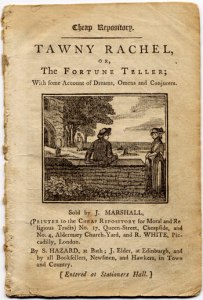 Tawny Rachel, or The Fortune Teller; With some Accounts of Dreams, Omens and Conjurers was a chapbook published in London in 1796. It tells the story of Rachel, a seeming “sun-burnt oracle of wisdom” who was actually a skilled con-artist (unfortunately they do exist).
Tawny Rachel, or The Fortune Teller; With some Accounts of Dreams, Omens and Conjurers was a chapbook published in London in 1796. It tells the story of Rachel, a seeming “sun-burnt oracle of wisdom” who was actually a skilled con-artist (unfortunately they do exist).
She used a variety of methods of fortune-telling from reading moles to dreams to the disposition of plants. Having found a gullible young girl who was eager to find a husband, Rachel explains:
“If you cross my hand with a piece of silver I will tell you your fortune. By the power of my art I can do this three ways; by cards, by the lines of your hand, or by turning a cup of tea-grounds: which will you have?”
Unfortunately there is no account of her reading the cards. Eventually she is arrested, found guilty and sent to Botany Bay:
“And a happy day it was for the county of Somerset, when such a nuisance was sent out of it.”
The author thought it was his duty
“to print this little history as a kind of warning to all you young men and maidens not to have any thing to say to cheats, impostors, cunning women, fortune-tellers, conjurers, and interpreters of dreams.” [He continues,] “Listen to me, your true friend, when I assure you that God never reveals to weak and wicked women those secret designs of his Providence, which no human wisdom is able to foresee.”
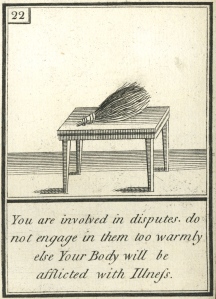 1794/6 – Viennese Coffee-Grounds and Cards
1794/6 – Viennese Coffee-Grounds and Cards
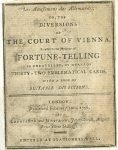 Meanwhile, in Vienna, in 1794, there appeared a deck of fortune-telling cards and book based on images commonly described as found in coffee-ground fortune-telling. With the advent of coffee to Europe and coffee-houses springing up starting around 1650, came the huge growth of coffee-house culture throughout Europe during the 18th century. Simultaneously a Turkish custom of fortune-telling by reading the images in coffee-grounds emerged (only later was this applied to tea-leaves). Lists of these images are first recorded in mid-18th century Germany, with the earliest detailed description being this Viennese book and deck. We know of it only through an English translation of 1796 that is found in the British Museum (see also my post about them here).
Meanwhile, in Vienna, in 1794, there appeared a deck of fortune-telling cards and book based on images commonly described as found in coffee-ground fortune-telling. With the advent of coffee to Europe and coffee-houses springing up starting around 1650, came the huge growth of coffee-house culture throughout Europe during the 18th century. Simultaneously a Turkish custom of fortune-telling by reading the images in coffee-grounds emerged (only later was this applied to tea-leaves). Lists of these images are first recorded in mid-18th century Germany, with the earliest detailed description being this Viennese book and deck. We know of it only through an English translation of 1796 that is found in the British Museum (see also my post about them here).
 1798/9 – Das Spiel der Hoffnung (“The Game of Hope”)
1798/9 – Das Spiel der Hoffnung (“The Game of Hope”)
In 1798-9, a young German game designer, Johann Kaspar Hechtel (1771-1799), in Nuremberg, designed a 36-card multi-purpose game featuring simple images (Dog, House, Mice, Anchor) that are nearly identical to 30 of the the Viennese Coffee-Cards. Hechtel’s 36 cards for his Der Spiel die Hoffnung (“Game of Hope”) were inset with playing cards – a common German-suited deck on the top left and French-suited deck on the top-right for playing regular card games. The game described was played by laying out the cards in a square of 6 cards-by-6 cards with instructions for a race-game similar to the Game of Goose or Snakes-and-Ladders. At the end of the instructions, Hechtel mentions that these cards can also be used for fortune-telling (with the assumption that everyone knew how). While French and English playing card meanings have no relevancy to the images, it turns out that there is an entirely separate tradition of German Wahrsagekarten (“Fortune Telling Cards”) featuring suits of Leaves, Hearts, Bells and Acorns whose meanings do accord with the Game of Hope cards (see a discussion here). The card to the right is the Jack of Clubs (Knave of Acorns), called “The Birchrod” meaning disputes (see the same Coffee-card image just above).
The 19th Century
Early 19th century – Costumes of Foreign People (French deck)
A 54-card deck, in the Metropolitan Museum of Art, dated to 1700-1799 and described in French as: ‘Composées de tous les Costumes des peuples / étrangers avec de jolies devises et bons mots. / dediées aux Jeunes Gens’; ‘Je me fixe a la plus belle / Imitez moi.’ (“Featuring all forms of dress of foreign peoples, with many fine sayings and proverbs. Intended for children. ‘I set my sights on Beauty: Do as I do!’”) Each card contains a picture featuring people dressed in the clothing from foreign countries (identified at bottom). Near the top are numbers (for a lottery or game?) and some have a day of the week. The Aces feature traditional images found in cartomancy decks. On the bottom right is an upside-down playing card inset above which is a meaning associated with it by Etteilla. Around the sides are short sayings and advice. It appears to be a multi-purpose game that can also be used for advice or fortune-telling. These are probably more accurately dated to the early 1800s based on the English clothing style.
1803 – Many a Fine Lady . . .
The popularity of cartomancy in France is attested to in 1803 by Francis W. Blagdon in Paris As It Was and As It Is:
Much about that period, 1572, there were reckoned, in Paris alone, no less than thirty thousand astrologers. At the present day, the ambulating magicians frequent the Old Boulevards, and there tell fortunes for three or four sous; while those persons that value science according to the price set on it, disdaining these two-penny conjurers, repair to fortune-tellers of a superior class, who take from three to six francs, and more, when the opportunity offers….
Formerly, none but courtesans here drew the cards; now, almost every female, without exception, has recourse to them. Many a fine lady even conceives herself to be sufficiently mistress of the art to tell her own fortune; and some think they are so skilled in reading futurity in the cards, that they dare not venture to draw them for themselves, for fear of discovering some untoward event.
This rage of astrology and fortune-telling is a disease which peculiarly affects weak intellects, ruled by ignorance, or afflicted by adversity. In the future, such persons seek a mitigation of the present; and the illusive enjoyments of the mind make them almost forget the real sufferings of the body.
1820 – Les Jeunes Femmes
A description of fortune-telling with cards by a maid for her lady was translated into English from Les Jeunes Femmes, of M. Bouilly and published in Belle Assemblee: Or, Court and Fashionable Magazine in 1820. In this work, Madame de Saucerre wishes to discover her husband’s activities on the previous night. What is revealed is another matter altogether. Read this story and learn the truth discovered here.
1830 – German Fortune-Telling Cards
We previously saw German cards with mottos or sayings on them. By 1830 a 32-card deck was published in Munich by Franz Josef Holler (made by Comptoir Industry of Leipzig), with fortune-telling meanings printed on them. This deck falls right between the 1799 Spiel der Hoffnüng game (the direct forerunner of the Lenormand cards) that is illustrated with both German and French playing cards, and the nearly identical 1846 German fortune-telling deck named after Mlle. Lenormand. In both decks, for instance, the 10 of Clubs (Acorns) features a picture of a Bear and has a meaning of “envy.” (See my post on the Lenormand playing card inserts HERE.)
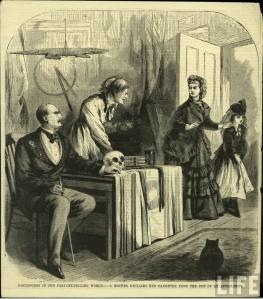 1836 & ’38 – American Cartomancers
1836 & ’38 – American Cartomancers
Extending back to the late 18th century, American newspapers report on fortune tellers using cards but usually only when they’ve been arrested for fraud. Here’s the earliest description I can find of professional readers in America—from The Burlington Weekly Free Press, Burlington, Vermont, July 1, 1836:
“Fortune Telling.—The Baltimore Transcript states that there are in that city no less than twelve professors of the art of divination or fortune telling. Most of them perform their incantations by the use of cards; but one old woman, wiser or more gifted than the others, pretends to delve into the mysteries of futurity by looking into an empty junk bottle! Strange as it may seem, the patrons of these vagabonds in the “Monumental city” are not confined to the low and vulgar. Some very genteel, respectable people—particularly ladies—run after these impudent imposters, to inquire after their future fate—as though “a tall, and mean, and meagre hag” knew more of the “shadows of coming events” than the beautiful and fascinating creatures whose bright eyes might if they would pierce into futurity even though it were a nether millstone.—Silly creatures! if they believe the predictions of these hags, they stand at least an even chance of making themselves miserable for life; if they do not, they certainly carry their time and money to a very bad market.”
The Public Ledger (Philadelphia) for January 10, 1838 carries this ad:
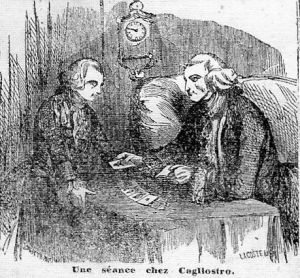 1838 – Julia Orsini
1838 – Julia Orsini
Julia Orsini wrote a book on reading with the Etteilla cards. In Le Grand Etteilla, ou l’art de tirer les cartes (Paris, 1838) containing a rare etching of a man reading the cards, identified as the scondrel, con-artist Count Cagliostro (1743-1795) who was made much of in Masonic circles.
1840/1853 – Rossetti’s Femme Fatale
Read about the poem, “The Card Dealer” (1853), that Dante Gabriel Rossetti wrote to Theodore von Holst’s painting “The Fortune-Teller” (1840) – here.
1846 – Petit Lenormand Deck
Upon the death of Mlle. Lenormand in 1843, as was the tradition, publishers began publishing Lenormand decks and books that had nothing to do with the original person. In France a 52-card Grand Jeu Lenormand deck was produced with designs taken from myth, constellations and flower oracles.
In 1846 in Coblenz, Germany we find the first Petit Lenormand – a 36 card deck (see cards below). It featured the same set of images found in the Spiel der Hoffnung, but with only the French-suited playing card inset. The sheet of instructions and card meanings, signed by a fictitious “Philippe, heir to Mlle. Lenormand” were nearly identical to the coffee-ground meanings and reading technique detailed in the Viennese Coffee-Card book (see above). The deck was soon produced by multiple publishers in Germany, Belgium, Sweden and the United States (where they were called, among other names, “Madam Morrow’s Fortune-Telling Cards). The earliest U.S. publications, found in Chicago and New York had bi-lingual German and American instruction sheets. Today these cards are experiencing a huge resurgence in interest.
Soon after, a wide variety of fortune-telling decks began appearing, usually called Sybilla or Gypsy decks, with a varying number of cards and images. Despite the emergence of dozens of fortune-telling decks, paintings and prints of cartomancers up until the late 20th century almost universally show only standard playing cards.
1863 – Chambers’ Book of Days
In 1863, Robert Chambers, with his Book of Days, published a two volume “miscellany of popular antiquities” organized around the calendar year. For February 21st, he includes an article on English cartomancy called “The Folklore of Playing Cards” (illustrated with the picture below). In it he gives the card meanings he was taught as a child when struck by illness in a foreign land. (Read the whole article here—you need to scroll down a ways.)
The English system is used in all British settlements over the globe, and has no doubt been carried thither by soldiers’ wives, who, as is well known to the initiated, have ever been considered peculiarly skilful practitioners of the art. Indeed, it is to a soldier’s wife that this present exposition of the art is to be attributed. Many years ago . . . the writer, then a puny but not very young child, [was] left for many months in charge of a private soldier’s wife, at an out-station in a distant land. . . . She was too ignorant to teach her charge to read, yet she taught him the only accomplishment she possessed,—the art of ‘cutting cards,’ as she termed it: the word cartomancy, in all probability, she had never heard.
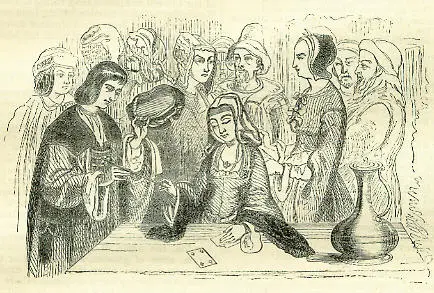 The above engraving that illustrated Chambers’ article first appeared in the Magasin Pittoresque in 1842 (according to Detleff Hoffmann). It loosely reproduces a painting by Lucas van Leyden that was later named The Fortune Teller (c. 1508) though it may actually commemorate a political negotiation mediated by Margaretha of Austria (see painting near the beginning of this post). Chambers’ meanings were used by A.E. Waite when he wrote his compendium on fortune-telling as “Grand Orient.” They appear almost intact in the supplemental meanings for the Lesser Arcana given in Waite’s Pictorial Key to the Tarot (1910).
The above engraving that illustrated Chambers’ article first appeared in the Magasin Pittoresque in 1842 (according to Detleff Hoffmann). It loosely reproduces a painting by Lucas van Leyden that was later named The Fortune Teller (c. 1508) though it may actually commemorate a political negotiation mediated by Margaretha of Austria (see painting near the beginning of this post). Chambers’ meanings were used by A.E. Waite when he wrote his compendium on fortune-telling as “Grand Orient.” They appear almost intact in the supplemental meanings for the Lesser Arcana given in Waite’s Pictorial Key to the Tarot (1910).
End of the 19th century
By the end of the 19th century we find all kinds of new fortune-telling decks springing up, including the Kipper Cards in 1873 (published by Matthias Seidlein and said to be created by a Frau Kipper), and various “Gypsy” and “Sybilla” decks each with their own emphasis on certain aspects of a daily life. Tarot was taking a huge leap forward as esoteric societies rushed to design occult decks and write books influenced by Antoine Court de Gébelin, Etteilla and Eliphas Lévi. The Tarot details are found in other posts and books.
To Sum It Up
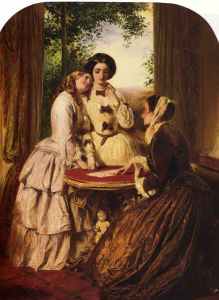 Never as ubiquitous as dice, palmistry or astrology, divination with cards goes back to at least the 16th century and probably earlier, though the form may not have been what we now call cartomancy, which emerged more recognizably in the 18th century. We can see from all the above that historically card divination was practiced mostly by illiterate gypsies, courtesans, soldier’s wives and old women, and by literate young women for whom it was a parlour game. It was largely scorned by men and more often officially ignored by legislation, until the stakes got higher. With the exception of Madame Lenormand’s fame, it wasn’t until a few men deemed the art worth mentioning and the decks or books worth writing that it was really acknowledged. Still, it was not to be taken too seriously and generally kept to the confines of frivolous social entertainment, yet all the while there was an underground of mostly older women who made a good, if precarious, living out of various forms of divination. (Out of more than 400 pre-1900 pictures I’ve found of cartomancers less than a dozen have been of male readers and most of them are making fun of the practice.) A. E. Waite integrated Chambers’ soldier’s wives card meanings into many of his Minor Arcana tarot interpretations, where they are still in use today.
Never as ubiquitous as dice, palmistry or astrology, divination with cards goes back to at least the 16th century and probably earlier, though the form may not have been what we now call cartomancy, which emerged more recognizably in the 18th century. We can see from all the above that historically card divination was practiced mostly by illiterate gypsies, courtesans, soldier’s wives and old women, and by literate young women for whom it was a parlour game. It was largely scorned by men and more often officially ignored by legislation, until the stakes got higher. With the exception of Madame Lenormand’s fame, it wasn’t until a few men deemed the art worth mentioning and the decks or books worth writing that it was really acknowledged. Still, it was not to be taken too seriously and generally kept to the confines of frivolous social entertainment, yet all the while there was an underground of mostly older women who made a good, if precarious, living out of various forms of divination. (Out of more than 400 pre-1900 pictures I’ve found of cartomancers less than a dozen have been of male readers and most of them are making fun of the practice.) A. E. Waite integrated Chambers’ soldier’s wives card meanings into many of his Minor Arcana tarot interpretations, where they are still in use today.
See more paintings of nineteenth century cartomancers here.
Additional Links
-
Watch the 45 minute History Channel TV special on “Secrets of the Playing Card.”
- The best source on the history of playing cards is The World of Playing Cards.
- See especially Ross Caldwell’s presentation on playing cards (including Tarot) in divination and magic for the International Playing Card Society, September, 2006 – here, and his more recent report on references in Spanish documents here. I want to thank Ross for his historical professionalism and dedication to setting the story straight with concrete evidence.
- An account of cartomancy that draws from Chambers: The Gaming Table: its Votaries and Victims, Vol. II (1870) by Andrew Steinmetz – here. A set of modern playing card meanings can be found here. Seaqueen’s examples of cartomancy readings with a wide variety of decks are here.
Updates:
2/1/2015: Lots of 17th and 18th century material added, including photos, a 1791/3 book on “card tossing,” and more information on the card and coffee-ground reading from 1730.
2/1/2014: Information on the Mamluk cards inscriptions below comes from The World of Playing Cards website. A few notes added on the Grand and Petit Lenormand decks.
5/2011: There are a scattering of references to cards and their use in “lots” (sortes) or fortune-telling from the 15th century on, including analogies between the four suits and characteristics such as the virtues and the elements. Recently Ross Caldwell discovered a treasure-trove of Spanish references that he describes here. He notes: “The main points to be taken from the recent discoveries are that, in Spain at least, there were professional cartomancers in the 17th century, and they used layouts with multiple cards and positional significations.” Follow the trail of evidence below (and add to it Ross’s recent contributions) to see the development of divination with cards.

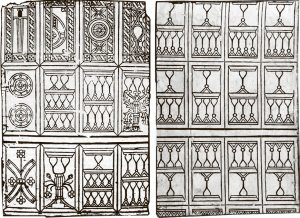

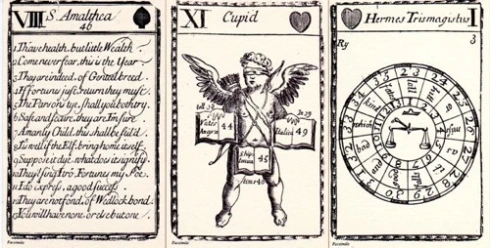
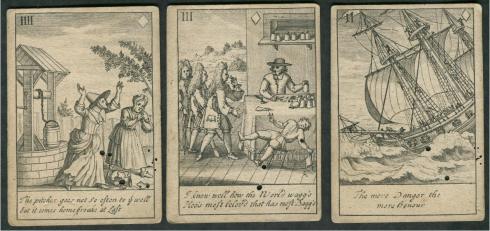
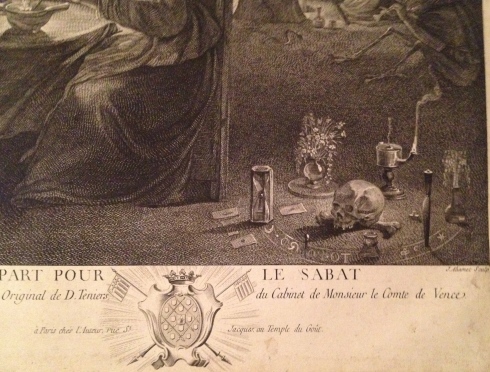
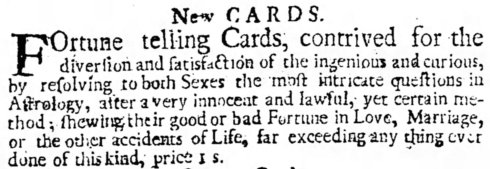
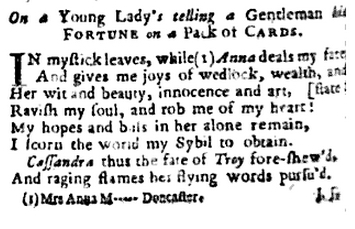
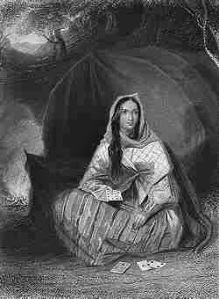
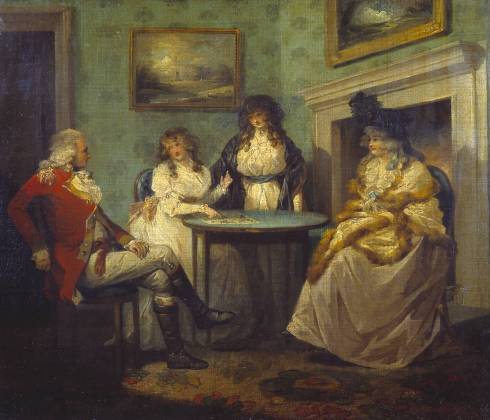
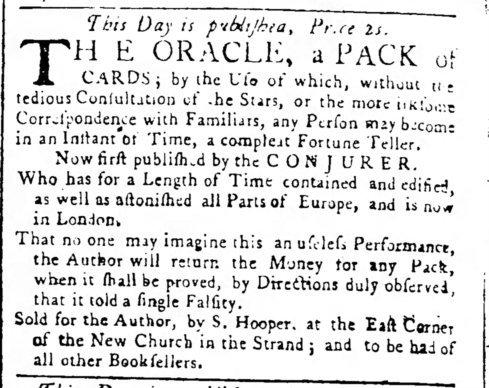
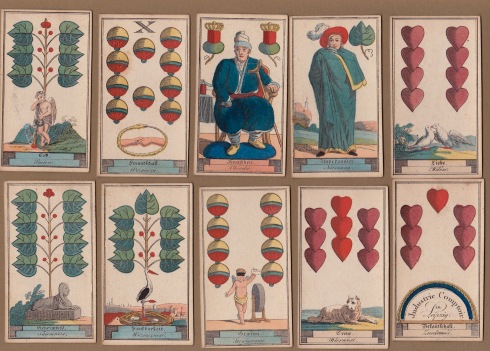
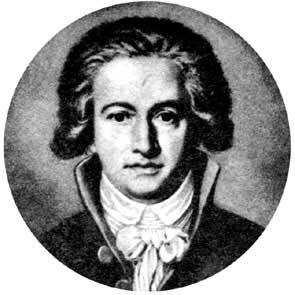
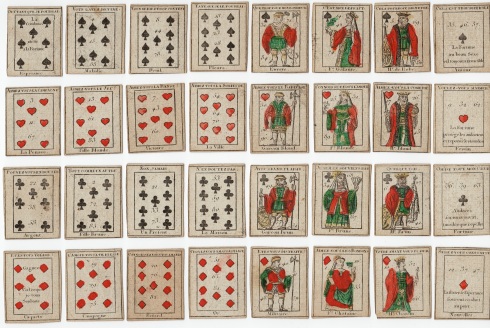
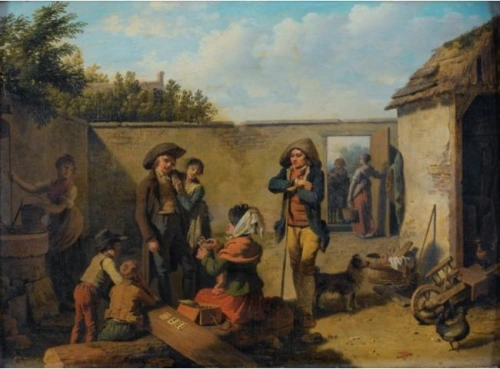
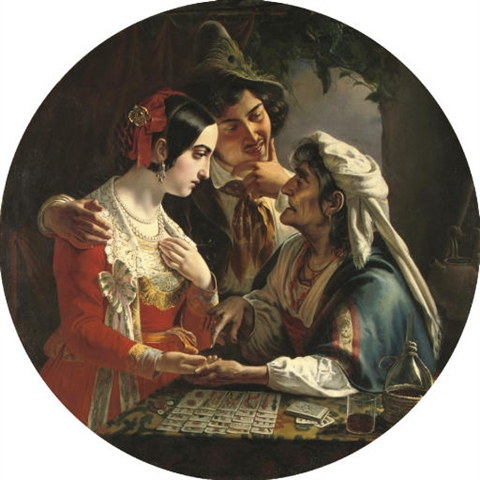
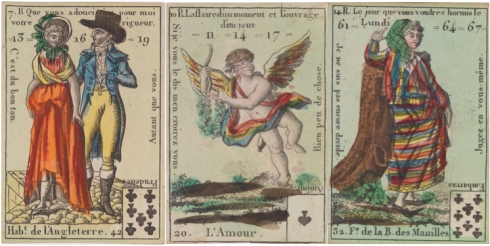
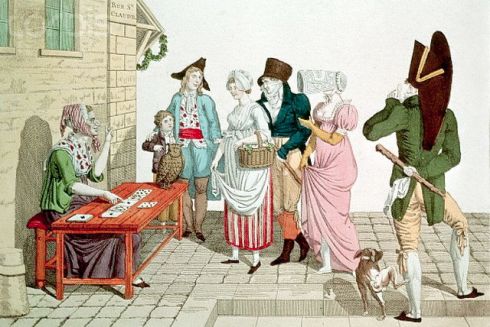
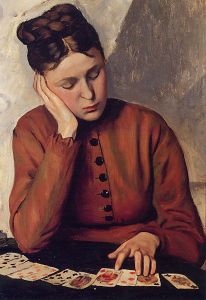
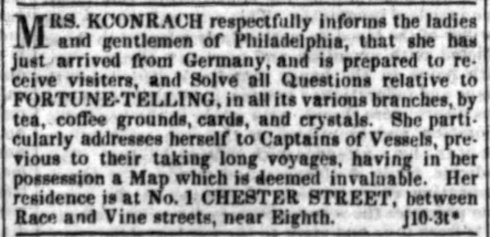
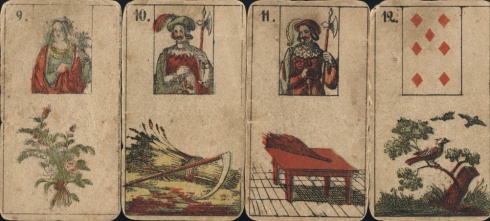
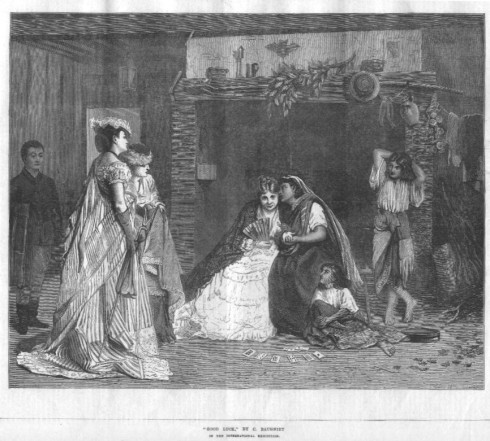
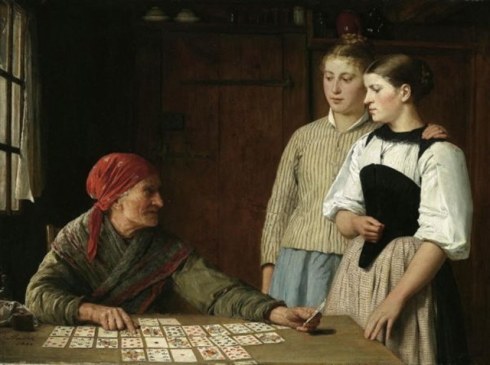
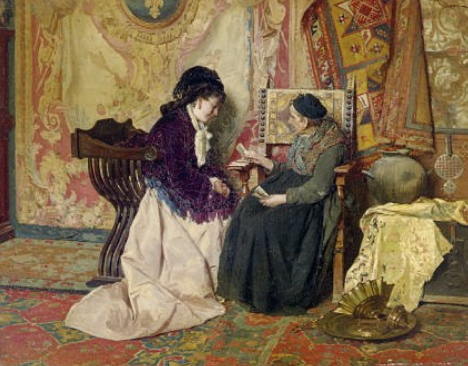
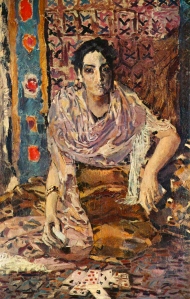
 Mary K. Greer has made tarot her life work. Check here for reports of goings-on in the world of tarot and cartomancy, articles on the history and practice of tarot, and materials on other cartomancy decks. Sorry, I no longer write reviews. Contact me
Mary K. Greer has made tarot her life work. Check here for reports of goings-on in the world of tarot and cartomancy, articles on the history and practice of tarot, and materials on other cartomancy decks. Sorry, I no longer write reviews. Contact me
35 comments
Comments feed for this article
December 4, 2008 at 8:10 pm
Jim
Thanks for this one. I was in fact looking precisely for a good history of cartomancy! Bookmarked for sure.
December 11, 2008 at 1:30 pm
Joanne
Thank you, this was awesome!
December 20, 2008 at 7:14 pm
tarocchi
Awesome…thank you very much for your article, there s always something to learn here!
January 17, 2009 at 12:57 pm
Ross Caldwell
Thanks for bringing these all together so concisely Mary! It’s great.
Please correct “in figuris chartaceo ludo pictUS” to “pictIS” – for the sake of the search engines, and the Latin.
I like Goethe’s reading, I had forgotten about it. Too bad for the younger girl.
January 17, 2009 at 2:45 pm
mkg
Ross – Correction made. Thanks so much.
January 28, 2009 at 5:30 am
Stirling
This was really interesting. It’s my first time on your website, Mary. I was intrigued because I was taught to first read cards with a deck of 52 before I learned to read Tarot. There are some similarities. I was taught by the daughter of a gypsy. I look back now and wonder how I even met her, but those were the 60’s when social boundaries were so blurred. Thanks for the great article.
February 5, 2009 at 6:52 am
Teresa
Thanks! Very enlightening.
March 23, 2009 at 12:39 pm
Ross Caldwell
This might interest you Mary –
I’ve put up various Spanish sources indicating cartomancy of different kinds, including ritual spells and fortune-telling, on Aeclectic –
http://www.tarotforum.net/showthread.php?t=115111
Ross
March 24, 2009 at 10:49 am
mkg
Ross – Thank you. This is wonderful material. I’ve added links to your report in the article text.
April 22, 2009 at 1:56 am
unicornus
Thank you very much. This is a great article!
July 20, 2009 at 11:34 pm
James Ricklef
Here are a few more for you. I don’t know when these paintings were painted, but I have provided either the artists’ birth/death dates or dates of activity.
Jehan Georges Vibert (1840-1902) — Fortune Teller
See: http://en.wikipedia.org/wiki/File:Jehan_Georges_Vibert_–The_Fortune_Teller,_private_collection.jpg
Josef Danhauser (1805 – 1845) — Napoleon Et Josephine Avec La Cartomancienne
See: http://www.passionforpaintings.com/art-gallery/josef-danhauser-painter/napoleon-et-josephine-avec-la-cartomancienne-oil-painting-reproduction
Emma Florence Harrison — Queen of Hearts.
I don’t know when she did this painting but the following link says c.1910
See: http://www.artmagick.com/pictures/picture.aspx?id=7487&name=the-queen-of-hearts
(I hope those links come through okay)
Bright Blessings,
James Ricklef
July 20, 2009 at 11:50 pm
mkg
James – You are fabulous! I have the Vibert painting – wonderful! But I wasn’t sure if it was cartomancy or a magic performance. What do you think?
The Danhauser painting illustrates my post on Madame Lenormand.
I hadn’t seen the Harrison one before. Sweet. However the Christina Rossetti poem it illustrates is about card games (although there is a mystical element to it).
I have several more images of cartomancers I haven’t posted yet. Am thinking about setting up a “Page” dedicated to just the art.
Thank you,
Mary
July 21, 2009 at 12:18 am
James Ricklef
I figured you were aware of the Vilber and the Danhauser since I had featured them in my 2008 LATS presentation and afterward emailed you with their info. But since I didn’t see them in this post, I thought maybe you’d lost them.
… Well, the Vilbert painting IS called “The Fortune Teller” but of course, that doesn’t prove anything. I tend to think it is indeed a fortune teller because there is no obvious interaction with the audience, which would be the case with card trick magic, and the setting is not in accord with actual magic(k). I guess it is subjective though.
I was not familiar with the Rossetti poem, but the look of the picture seemed more like cartomancy than a card game. Perhaps it (the painting) was just intended to pick up the mystical element? Or perhaps Harrison intended a veiled reference to divination?
Best,
James
November 11, 2009 at 1:21 am
Alexandra Nagel
Nice work!
For those who are interested: A couple of years ago I have done also research on Lucas van Leyden’s painting “The Card-reader”. The outcome has been published as ‘An Enigmatic Betrothal on Lucas van Leyden’s Painting The Card Reader’ in “The Playing-Card” 33(2), 2004: 96-108.
“The Playing-Card” is the journal of the International Playing-Card Society, http://i-p-c-s.org/.
May 5, 2011 at 11:51 am
Bertrand
Hello Mary,
this might be of interest too, by Mr.de la Barre de Beaumarchais, in 1738, about cartomancy in Holland :
(sorry for the awkward translation)
http://books.google.fr/books?id=c6s9AAAAcAAJ&pg=PA154#v=onepage&q&f=false
at about the middle of the page, starting from : “Ce genre de divination … ”
“That kind of divination is not the only one that still persists in Holland, despite its inhabitants common sense. Pyromancie and Ooscopy, or to speak in a more casual way, art of guessing by watching a flame, burning coal, sparkles, eggs in a glass, are still commonly used in some part of Holland. The fortuitous disposition of a playing card deck is another way to tell the future, not despised by certain ladies from this country. It is true that some of them pretend consulting the so-called witches for the sake of distraction. But one would think the exact opposite, seeing how they await with an attentive and worried attitude these women answers, and how they manifest their joy by the sudden serenity on their faces, when those Oracles are favorable.”
(I hope this translation is understandable)
May 5, 2011 at 12:26 pm
mkg
Bertrand –
Thank you so much for letting me know about this! It appears you left a couple of important words out of your translation – the layout of the cards:
“The fortuitous disposition of a playing card deck open (face-up?) and arranged in four or five lines is another manner of divining the future, that some ladies of this Province do not despise.”
I’ll add this to the post.
May 7, 2011 at 5:28 am
Bertrand
Hello Mary,
you’re definitely right, and I’m sorry for not rereading ! I’m glad you noticed this omission because this is indeed an important and significant detail.
Bertrand
November 12, 2011 at 4:46 am
هاست ویندوز
This could be the greatest piece I have read.
November 5, 2012 at 12:03 am
Tarot Cirkel
Thank you for mentioning this article on facebook. Your blog is really a source of information and inspiration.
November 28, 2012 at 8:02 am
horoscopo de hoy gratis
Pretty great post. I simply stumbled upon your blog and wished to mention that I have truly enjoyed surfing around your blog posts. After all I will be subscribing on your feed and I hope you write again very soon!
August 8, 2013 at 7:51 pm
Cartomancie - Voyance
[…] « Origins of divination with playing-card » par Mary GREER […]
September 12, 2013 at 1:14 am
rachel
great blog about cards, I haven’t seen a blog with this much depth thanks so much I will be back!
March 26, 2014 at 1:33 pm
Ancienne référence à la cartomancie en Espagne | tarotparis.com
[…] le blog de Mary Greer se trouve une compilation assez bien tenue de références à l’utilisation de cartes dans la divination.Si le sujet dépasse la tarotologie exclusivement, englobant toutes sortes de cartes à jouer, à […]
September 2, 2014 at 10:45 am
A Short History of Playing Card Divination | Black Knight
[…] Mary K Greer: Origins of Playing-Card Divination. […]
May 4, 2015 at 10:30 am
nataliaclarke
Blimey, what a piece. I am relearning fortune telling with playing cards, which I leant as a teenager from my grandma.
Thanms
April 6, 2018 at 8:36 pm
Ioasaph Vespertine
> Composées de tous les Costumes des peuples / étrangers avec de jolies devises et bons mots. / dediées aux Jeunes Gens’; ‘Je me fixe a la plus belle / Imitez moi.
I read as: “Featuring all forms of dress of foreign peoples, with many fine sayings and proverbs. Intended for children. ‘I set my sights on Beauty: Do as I do!’”
April 7, 2018 at 3:14 pm
mkg
Ioasaph,
Thank you for the corrections to my translation. I appreciate your taking the time to read this closely and respond.
Mary
March 1, 2019 at 7:24 am
Marie Anne Lenormand : HerStorie | Women of the World
[…] Greer, Mary K. “Origins of Playing Card Divination,” Mary K. Greer’s Tarot Blog. […]
October 1, 2019 at 11:08 am
dounia
Reblogged this on sortilège spiritualité et magie and commented:
les origines de la cartomancie ( englais)
January 19, 2020 at 6:15 am
Soul Pictures – Stumbling Around in the Dark
[…] When it comes to divination, though, I prefer the Tarot. We can’t be really sure when the Tarot was first used for divination. I figure that didn’t happen widely until after the development of printing in Europe during the 15th century. Prior to the ability to mass produce cards, decks were all one-offs, each hand painted, expensive and works of art. Mary K. Greer has a good article on her blog regarding divination with cards. (https://marykgreer.com/2008/04/01/origins-of-divination-with-playing-cards/) […]
March 12, 2020 at 4:13 pm
Cartomancy – What Magic Is This?
[…] Origins of Cartomancy – Mary K. Greer’s website is a treasure if Cartomancy is up your alley […]
February 28, 2021 at 2:05 pm
Tarot | Vipera Helix
[…] is called cartomancy. If you are interested in the origins and history of cartomancy, I recommend this article by Mary K. […]
October 11, 2021 at 9:30 am
Karty cygańskie „Sybilla della Zingara” – recenzja talii – Między kartami
[…] Źródła: „Gypsy Oracle Cards: A Handbook for Interpreting the Sibilla della Zingara”, M. Jacqueline Murrayhttps://de.wikipedia.org/wiki/Zigeunerkartenhttps://de.wikipedia.org/wiki/Lenormandkhttps://de.wikipedia.org/wiki/Kipperkartenhttps://www.youtube.com/watch?v=9Q4hI6FnqNIhttps://sibillashahar.blogspot.com/2015/05/troche-historii.htmlhttp://www.itarocchidigabriella.it/sibille.htmhttps://www.tarocchi-cartomanzia.it/cartomanzia/sibille/http://www.fortune-telling-cards.com/Sibilla-Gypsy-Cards.phphttps://tarotator.com/the-gypsy-fortune-telling-cards/https://marykgreer.com/2008/04/01/origins-of-divination-with-playing-cards/https://it.wikipedia.org/wiki/Sibille_Lenormand […]
October 18, 2021 at 1:08 pm
Karty cygańskie „Zigeuner Wahrsage-Karten” i dalszy ciąg tego, skąd wzięły się karty cygańskie – Między kartami
[…] Źródła: |https://de.wikipedia.org/wiki/Zigeunerkartenhttps://www.astrozeit24.de/zigeunerkarten/Zdjęcie Habsburgów: https://www.flickr.com/photos/37578663@N02/9688237846/Zdjęcie munduru: https://www.alamy.com/stock-photo-military-austria-hungary-uniforms-officers-lieutenant-photograph-by-11641243.htmlhttps://en.wikipedia.org/wiki/Austro-Hungarian_Armyhttps://www.wopc.co.uk/germany/weigelhttps://www.wopc.co.uk/germany/industrie-comptoir/fortune-telling-deckhttps://marykgreer.com/2008/04/01/origins-of-divination-with-playing-cards/ […]
January 29, 2024 at 9:28 am
Escolhendo um oráculo – O Zigurate
[…] um jogo de azar para tirar a sorte, e os primeiros indícios de práticas de cartomancia datam do século XV. A princípio o termo “cartomancia” se refere ao uso de baralhos comuns mesmo, mas a grande […]